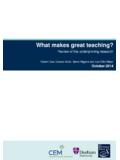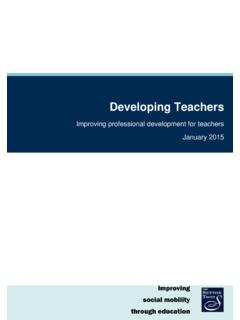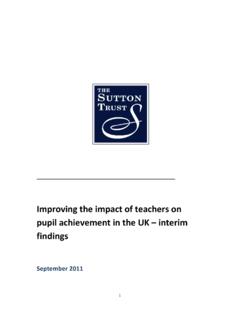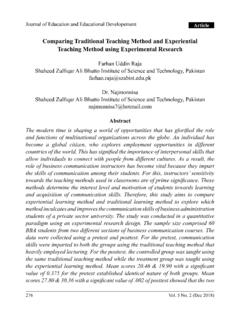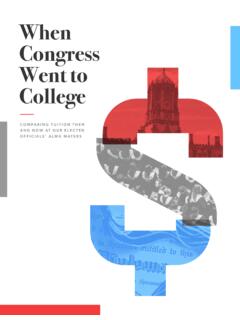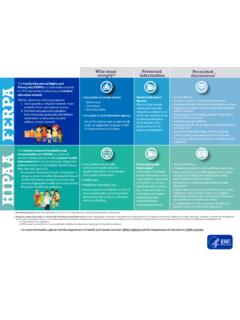Transcription of Educational Background of UK Members of Parliament
1 The Educational Backgrounds of Members of Parliament in 2010 May 20101 Key FindingsSchool backgrounds of MPs Over one third (35%) of MPs elected in the 2010 General Election attended independent schools, which educate just 7% of the school population. The proportion of MPs attending independent schools is 3 percentage points higher than in the previous 2005 Parliament bucking a trend during recent decades that has seen the proportion of privately-schooled MPs gradually fall. A major factor behind the increase in the rise is the higher number of Conservative MPs - who are much more likely than their Labour peers to have been privately-schooled.
2 Less than half (43%) of MPs were educated in comprehensive state schools, with the remainder having attended state grammar schools (22%). 54% of Conservative MPs attended fee paying schools, compared with 40% of Liberal Democrat MPs, and 15% of Labour MPs. There are 20 Etonians in the 2010 Parliament -- 5 more than those who served in the 2005 Parliament . Overall 13 schools (12 of which are fee-charging) produce a tenth of all MPs in the new Parliament . 35% of newly elected MPs for the 2010 Parliament attended independent schools, the same proportion as MPs who were re-elected.
3 University backgrounds of MPs Nine in ten MPs in 2010 attended university by far the highest proportion of any Parliament to date. This includes just under three in ten who were educated at either Oxford or Cambridge universities. Oxford has produced 102 MPs serving in the 2010 Parliament . 38% of Conservative MPs were educated at Oxford or Cambridge compared with 20% of Labour MPs and 28% of Liberal Democrat MPs. Newly elected MPs were even more likely to be graduates with 94% attending a university, including 69% who had attended a leading research university, and 28% who had attended Oxbridge.
4 2 Introduction & MethodologyThis note is the latest in a series of reports by the Sutton Trust on the school and university backgrounds of those in a number of leading professions and influential walks of life, including Members of Parliament1. The analysis of newly elected and re-elected MPs for the 2010 Parliament provides an initial update to the Trust's report on the 2005 Parliament2, which summarised the Educational backgrounds of MPs, Lords, and Members of the Government and shadow surveys suggest that social mobility levels are low among the highest echelons of British society.
5 The majority of those holding the most powerful and influential positions in modern Britain come from a small social elite, and are not reflective of the wider society which the professions are intended to serve. Independent schools make up 7% of the school population, yet constitute over half of leading news journalists, medics, chief executives, and 70% of barristers and judges. The problem is that these schools are effectively closed to the vast majority of parents unable to afford the fees, and so the majority of children are consequently unable to access the expertise and facilities available at such schools -- and stand a much lower chance of entering the creation of the country's social elites is largely a result of Educational inequalities exhibited in the school and university system.
6 Children at leading independent and state schools dominate entry to the country's most highly academically selective universities, which in turn produce the lion's share of graduates in the issues are particularly important for Parliament which is intended to represent the people's interests, and which will witness in 2010 the biggest change in its membership in decades. It is also Parliament that is ultimately responsible for our national education policy. And each MP would surely hope that talented children in the state schools in their own constituencies stand the same chances of becoming a future MP as those children from an elite cadre of schools largely serving the school and university backgrounds of MPs were obtained by using a number of publicly available sources, such as Who s Who, and MPs' websites, and by contacting prospective MPs directly.
7 Using historical data gathered by the Trust over a number of years, schools were then categorised according to their status at the point at which the MP would have entered the school - often different to the current status of schools. Schools were classified as non-selective state, state grammar, or independent. Universities meanwhile were classified 1 For a summary, see: See: The Trust will subsequently publish a fuller update report considering the Educational backgrounds of Lords and Parliamentarians holding offices within the three main parties in the 2010 a number of acknowledged groupings: Oxbridge.
8 And leading research universities, defined by membership of the Russell Group or the 1994 are extremely grateful to the communications consultancy, the Madano Partnership, for providing a series of analyses on the new MPs for the new Parliament , which has enabled the Trust to produce this analysis immediately after the results of the analysis is based on the school and university backgrounds of all Members of the House of Commons for whom sufficient data were available. school Background information was collected on 620 (96%) of the 649 MPs, with 9 MPs educated abroad, one home-educated, and two who went to specialist schools.
9 No data was available for the remaining MPs: information on schools was not listed in their Who's Who entry or alternative official sources; or MPs did not respond to inquiries sent by email. Information on university attended was collected for 540 MPs, with another 62 MPs who did not go to university, and five who went to university outside the UK. There was no available data for the remaining figures compiled for the 2010 Parliament have been compared with those compiled by the Trust for the 2005 Parliament . In order to look at trends in the Educational profile of the Commons over the last half-century, we have also used official data, and information provided in the series of books produced by Denis Kavanagh and David Butler after each General Election5.
10 4 See: The British General Election of 1951, 55 .. 2005, David Butler and Denis Kavanagh4 school attendanceSchool backgrounds of Members of the 2010 ParliamentThe following table documents the proportion of MPs in the newly created 2010 Parliament attending different types of school , broken down by the main political 1: school backgrounds of Members of the 2010 Parliament (educated in the UK) Total with known data Ind%State Comp%State Sel%ALL MPs660821435%25041%14424%Labour2423715%1 3957%6627%Conservative28315354%7527%5519 %Liberal Democrat552240%2138%1222%ALL MAIN PARTIES58221237%24841%12223%Overall, over one third (35%) of MPs have been schooled in the private sector, which educates just 7% of school children in the country.



